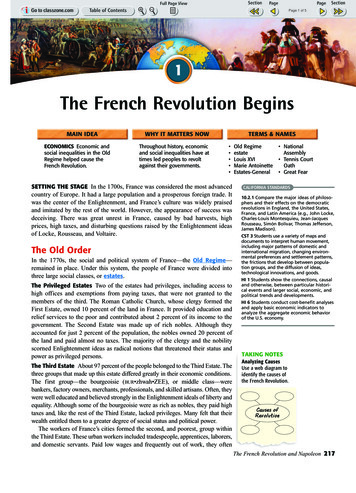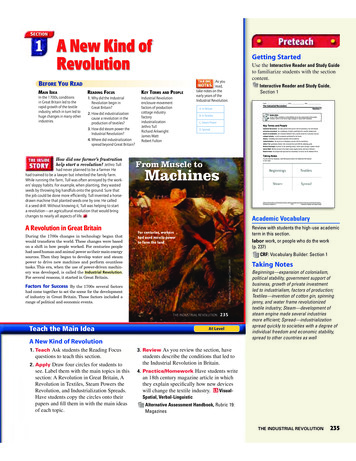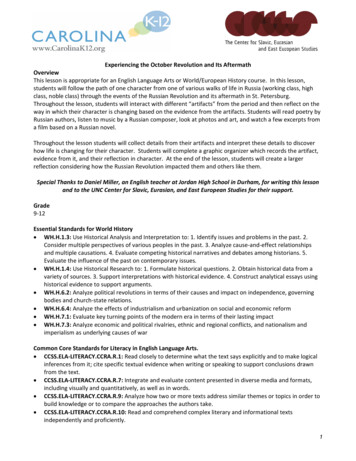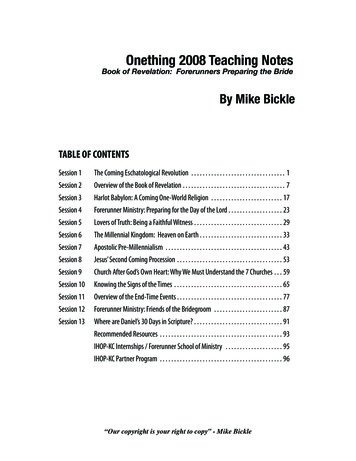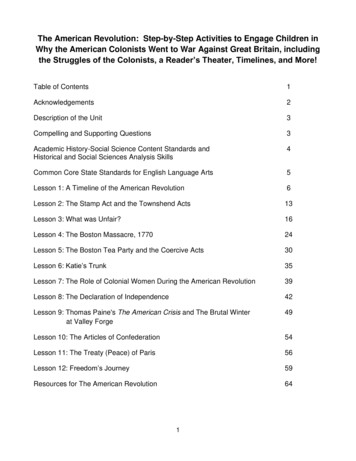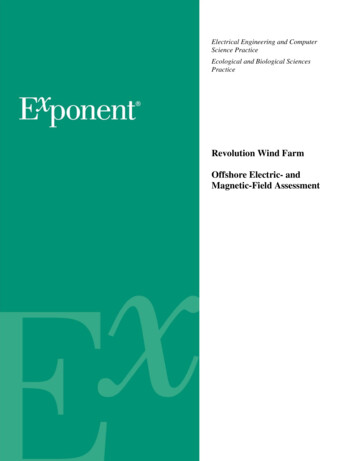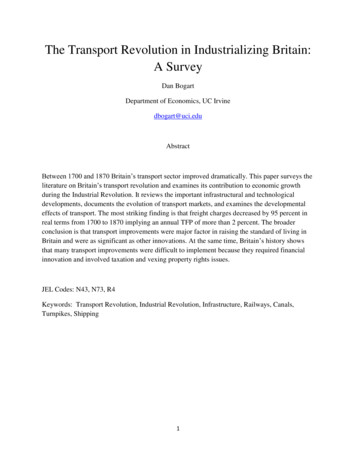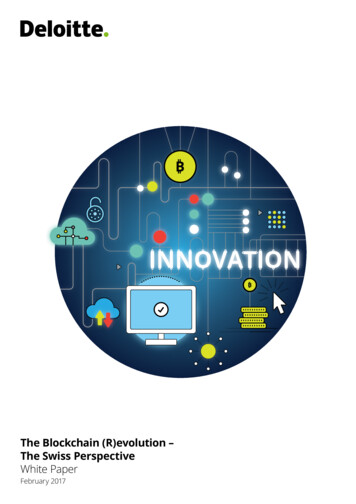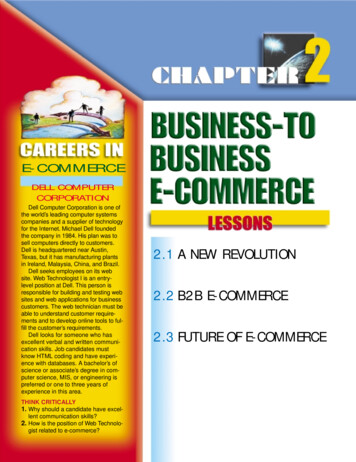
Transcription
E-COMMERCEDELL COMPUTERCORPORATIONDell Computer Corporation is one ofthe world’s leading computer systemscompanies and a supplier of technologyfor the Internet. Michael Dell foundedthe company in 1984. His plan was tosell computers directly to customers.Dell is headquartered near Austin,Texas, but it has manufacturing plantsin Ireland, Malaysia, China, and Brazil.Dell seeks employees on its website. Web Technologist I is an entrylevel position at Dell. This person isresponsible for building and testing websites and web applications for businesscustomers. The web technician must beable to understand customer requirements and to develop online tools to fulfill the customer’s requirements.Dell looks for someone who hasexcellent verbal and written communication skills. Job candidates mustknow HTML coding and have experience with databases. A bachelor’s ofscience or associate’s degree in computer science, MIS, or engineering ispreferred or one to three years ofexperience in this area.THINK CRITICALLY1. Why should a candidate have excellent communication skills?2. How is the position of Web Technologist related to e-commerce?2.1 A NEW REVOLUTIONDiscusses business-to-business e-commerce and the stagesof the business cycle.2.2 B2B E-COMMERCEDescribes the parts of a business transaction and models ofe-commerce.2.3 FUTURE OF E-COMMERCEExplains how large corporations are using e-commerce forbusiness-to-business transactions.CAREERS IN E-COMMERCEThink Critically Answers1. The candidate must communicate with the businesscustomer and develop a web site with written text that willbe read by web site visitors.2. The Web Technologist creates a virtual store for ane-commerce business.
The Chapter 2 video forthis module introduces theconcepts in this chapter.Compare RevolutionsPROJECT OBJECTIVES Compare the e-commerce revolution and the Industrial Revolution Examine the direction of business-to-business e-commerceGETTING STARTEDRead through the Project Process below. Make a list of any materials you willneed. Decide how you will get the needed materials or information. In small groups, have some members complete an Internet search for dates ofthe major events and turning points of the Industrial Revolution. Have other members complete an Internet search for the dates of some of themajor events and turning points in the history of e-commerce.PROJECT PROCESSPart 1 LESSON 2.1 Choose five major events that occurred during theIndustrial Revolution. Using spreadsheet software, make a timelinegraph showing the dates of these major events.Part 2 LESSON 2.2 Choose five major events that have occurred during theevolution of e-commerce. Make a timeline graph of the major events todate.Part 3 LESSON 2.3 List the similarities and differences between the IndustrialRevolution and the changes brought about by e-commerce. Predict thefuture direction of e-commerce based on what happened in the IndustrialRevolution.CHAPTER REVIEWProject Wrap-up Create a three-minute presentation that compares and contrasts the Industrial Revolution and the evolution of e-commerce. Make and support a prediction of the future of e-commerce.TEACHING RESOURCESInstructor’s Resource CDLesson Plans, Ch. 2PowerPoint Slides, Ch. 2Video Discussion Guide, Ch. 2Data Activities, Ch. 2ExamView Pro CDCh. 2VideocassetteVideo Segment, Ch. 2b2000.swep.comInternet Activities, Ch. 2PROJECTGetting Started Discuss whyknowing history can help predictthe future. Point out similaritiesbetween past and currentevents.Part 1 Review the use ofspreadsheet software withstudents.Part 2 Discuss what mightconstitute a major event ine-commerce, such as openingthe Internet to commerce.Part 3 Review the comparisonof the past and present tomake future predictions aboute-commerce.Project Wrap-up Discuss thefollowing: The five stages of revolutionary/evolutionary development — experimenting,financing, organizing, competing, and consolidating Wireless use and changes indistribution channels in thefuture Innovative uses of wirelessdevices in business Continued growth of intermediaries and consortia forpurchasing25
CHAPTER 2 BUSINESS-TO-BUSINESS E-COMMERCELESSON 2.1A NEW REVOLUTIONDESCRIBE business-tobusiness e-commerceEXPLAIN the stagesof the e-commercerevolutionScheduleBlock 45 minutesRegular 1 class periodFOCUSOn the SceneLead students in a discussionthat reflects back on thechannels of distribution learnedin Chapter 1. Some musicianssell their music directly toconsumers over the Internet,but most music sites areretailers or distributors forrecording companies.TEACHManaging the velocity ofthe changes occurring ine-commerce is a challenge toe-commerce entrepreneurs.Business-to-consumer transactions are familiar to students,as they resemble regular retailpurchases. Business-tobusiness (B2B) transactionsmay not be something studentshave thought much about.BUSINESS-TO-BUSINESSbusiness transactions are replacing traditional methods of commerce at a rapid rate. New companies are being created to handle changesEin lectronicthe marketplace, and existing companies are forming partnerships thatwould have been considered unthinkable ten years ago. From huge corporations to very small businesses, electronic commerce is changing the way business is conducted. Some businesses have been slower than others to adoptthis new method of commerce. However, e-commerce is eliminating time,distance, and location as factors in business transactions. WHAT IS B2B?Most Internet users are familiar with business-to-consumer transactions. Abusiness-to-consumer transaction occurs when you visit a web site and purchase an item, such as a book, that is being offered for sale. However, otherbusiness transactions must take place before you make that purchase. A publisher and an author reach an agreement and sign a contract. These negotiationsEmilia Cruz enjoys listening to music from her favorite recording artists, butshe does not have time to go to the mall to visit music stores. She haslocated a web site where she can shop for CDs online. Can you think of anybusiness transactions that would need to occur before the CDs are sold fromthat web site?26
2.1 A NEW REVOLUTIONmay take place over the Internet. The author writes the book and sends it to thepublisher. The book is edited and sent to a printer. The printer might purchaseits paper and ink over the Internet. Finally, a bookstore orders the book from thepublisher and pays for the book, possibly completing both of these processeselectronically. Many business-to-business e-commerce transactions take placebefore a consumer can buy a product. Business-to-business (B2B) transactionsare transactions made by one business with another over the Internet.The number of people making purchases over the Internet continues togrow at a tremendous rate. Most people are familiar with purchasing itemselectronically. Although business-to-business transactions are less familiarthan business-to-consumer transactions, the number of B2B transactions maysoon be greater than the number of business-to-consumer transactions on theInternet. In 1999, approximately 127 billion worth of business was conducted over the Internet. By 2003, it is estimated that 1.4 trillion worth ofcommerce will be conducted over the Internet and that 85 percent of thosetransactions will be B2B. Business-to-business transactions may reach 7.29trillion by 2004. In early 2000, PricewaterhouseCoopers, a consulting firm,conducted a survey of large companies. Most of the 83 companies surveyedhad more than 1 billion in annual revenue. However, only 28 percent of thecompanies in the survey could conduct business online. The survey confirmed that businesses were slowly discovering the benefits of e-commerce. AT THE STARTSome of the earliest users of e-commerce were travel agents, who discoveredthat they could book airline reservations electronically. Special hardware andsoftware allowed the travel agents to exchange information electronically.This process was referred to as electronic data interchange (EDI). However,EDI was expensive and difficult to use. Only 2 percent of the businesses inthe United States attempted to use EDI. The amount of time and moneyinvolved prevented any real savings from taking place.Because EDI was so expensive, some companies were not eager to exploretaking their businesses online. Currently, companies are interested in usingthe Internet for business-to-business transactions because they can increaseAIRLINES OF THE WEB Airlines of the Web (AOW!) offers one-stop shopping for people who travel for business or for pleasure. The AOW! web sitecontains interactive tools that allow people to answer questions about theirtravel needs. The AOW! site contains information such as flight times anddestinations, ticket prices, and hotel accommodations. Approximately 500airlines advertise on the AOW! web site. Other businesses such as restaurants, hotels, and shopping malls advertise there, too. AOW! searches itsdatabase to find the best deals for each traveler. Airline tickets can then bepurchased online.THINK CRITICALLY Why do you think airlines and restaurants would wantto advertise on a web site such as Airlines of the Web? How could thisadvertising benefit you?In early 2000, the U.S.economy was startingto show signs ofstalling due to the lackof technically skilledworkers needed to fillexisting jobs. Write afew paragraphsexplaining how ecommerce affected thenumber of skilledworkers available.COMMUNICATEAsk students about the employment rate in their area. Arepeople without jobs becausetheir skills do not match currentjob openings? Can studentsprepare for jobs that will existwhen they enter the workforce?TEACHTraditional businesses wereslow to embrace B2B transactions, but they became moreinterested when the advantages of an online presencebecame apparent.Electronic Data Interchange(EDI) was an early version ofe-commerce. The drawbacks toEDI may have hindered viewson the potential of the Internet.TECH TALKAsk how many students haveused or know of someone whohas used a travel web site.Think Critically AnswerThey could attract additionalbusiness. This type of aggregator of data from multiple companies would help consumers getlower prices.27
CHAPTER 2 BUSINESS-TO-BUSINESS E-COMMERCEWork in pairs. Select ane-commerce web sitewith which you are bothfamiliar. Discuss thekinds of transactionsthat might need to takeplace before this website offers products tocustomers. Make a listof the transactions, andshare the list with theclass.WORKSHOPPrepare a list of web sites fromwhich the students may choose,such as amazon.com, yahoo.com, or ebay.com. During thepresentations, look for signsthat students understand thechannels of distribution.ONGOING ASSESSMENTAsk students to select one ofthe goals listed at the beginning of the lesson and write aparagraph that shows theirunderstanding of the topic.TEACHSee if students can recognizewhat stage e-commerce iscurrently in. In the early 1990s,e-commerce was in the experimentation stage. People weretrying to figure out what to dowith it. In the mid to late 1990s,venture capital was readily available, and people were makingand losing millions. By 2000, dotcoms were hiring managers toturn the companies into profitmaking businesses.28profit by saving time and cutting the cost of materials. Businesses are taking ahard look at practices that require large amounts of time and personnel tocomplete. The Industrial Revolution brought about mass production of theautomobile by using standardized auto parts. E-commerce is providing information about and access to products in a fast and efficient manner. Businessowners who once spent hours selecting needed materials, typing bids, mailingthe bids, waiting for responses to the bids, typing purchase orders for theselected products, and then waiting a week or more for delivery can speed upthe process dramatically by ordering online. When a seller makes it knownthat products are available on its web site, an order can be placed electronically and received by the seller in minutes. Products can be shipped the sameday for overnight delivery.Give an example of business-to-business e-commerce.PROCESS OF INNOVATIONT he process of innovation usually goes through five stages of development.1. Experimentation2. Finance3. Organization4. Competition5. ConsolidationExperimentation During theexperimentation stage of an innovation,people are just beginning to recognizethe possibilities for the new technology.People are experimenting with newideas.Finance During the finance stage,the innovators are trying to findinvestors to fund the idea and to pay thebills until profits start. People whofinance new companies may win or losehuge fortunes.Organization The organizationstage begins with new management and
2.1 A NEW REVOLUTIONorganization of the company. Theindividual who has the new ideais frequently not the person whohas the ability to run the businesswhen the company is started.Organizing and managing a company require special skills. Themanager must establish the brand,develop the customer base, andoversee people and finances.Competition As the company grows older, it enters thecompetition stage, where it eithersucceeds or fails. If the companybegins to fail, investors will usually stop providing funding. Ifthe company is successful, it willattract the attention of peoplewho may try to establish competitive businesses. Larger companiesmay try to purchase a small successful company, especially if that company isa competitor. Most investors see this as the time to sell and take their profits.Consolidation At this point, the consolidation stage begins. The industry merges into a few large companies. Then the cycle starts again when anew technology takes shape as an idea in someone’s mind and experimentation begins. STAGE OF THE E-COMMERCE REVOLUTIONAt the turn of the century, the United States was about halfway through thefinance stage of the e-commerce revolution. There were thousands of successful Internet-based businesses, and ideas and financing were plentiful. Manyof the larger corporations were taking advantage of this new technology, too,as they went online to conduct business. The largest e-commerce companieswere raising money to buy the best of the small e-commerce companies.Other companies were left to fail.As the world emerged from the earliest stages of the e-commerce revolution, ideas on how to use the Internet continued to develop. E-commerce willrestructure the supply and distribution systems, reduce the cost of doingbusiness, and help develop the global e-commerce marketplace.TEACHING STRATEGIESAuditory LearnersAsk the auditory learner tostate the stages of innovation.After each statement, askanother student to define thestage out loud.TEACHDiscuss with students why theperson who manages thecompany might be someonedifferent from the person whothought of the ideas andstarted the company. Askwhich they would rather do, ifboth paid the same.When someone finds a newway to make money, manypeople rush to do the samething. Eventually the market isoverloaded, but the competitionforces businesses to continueto improve their products andkeep the prices as low aspossible.Consolidation is taking placeas large companies buysmaller ones.In May 2000, Chris Thomas,Director of Strategic Marketingfor Intel Corporation, made apresentation at a CompaqComputer conference inHouston, Texas, titled “The 3rdGeneration of InternetBusiness.”ONGOING ASSESSMENTAssign students to groups, andask them to develop ideas foronline businesses, focusing onthe five stages of innovation.Have each group present itsplan to the class.Describe the e-commerce revolution in your own words.29
CHAPTER 2 BUSINESS-TO-BUSINESS E-COMMERCERETEACHHand out pages numbered 1 to5 to students, and ask them tolist the five stages of innovation.ENRICHAsk students to visit a companyweb site and open the link thatprovides background informationon the company. After readingabout the company, studentsshould write a summary of whathappened during the company’sstages of innovation.ASSESSAsk students to describe thedevelopment stages of innovation. You should look for thefive stages: experimentation,finance, organization, competition, and consolidation.CLOSEHave students visit theamazon.com web site, andchoose one type of productthat is sold at the site. Studentscan make a list of the kinds ofB2B transactions that mighttake place before a consumerbuys a product.THINK CRITICALLY1. Why did so few businesses use EDI for business transactions?EDI was too expensive and complicated and had limited use.2. Give an example of how a company might save time and money byusing the Internet.Answers will vary. A correct example might include a traditional process that takestime and requires a lot of paperwork, such as ordering supplies, compared to doingit online.3. Describe an early use of e-commerce.Idea people were rapidly thinking of new ways to save time and money using theInternet for transactions.4. What will happen to the number of Internet companies in the laterstages of the revolutionary change?The weakest companies either will be bought by large companies or cease to exist.MAKE CONNECTIONS5. COMMUNICATION Visit a web site that is involved in e-commerce.Explore the site, and write a paragraph describing the business.Answers will vary. Provide a suggested list of e-commerce web sites for students tovisit, such as e-steel.com.6. RESEARCH Revisit the web site from question 5. What stage ofe-commerce best describes that business? Make a list of reasonsyou chose that stage.Answers will vary based on the web site used.7. PROBLEM SOLVING Create a spreadsheet. Use the five stages ofinnovation as column headings. Under each column head, indicate bywriting “yes” or “no” whether the web site you visited in question 5 hasany of the characteristics of that stage.30
2.2 B2B E-COMMERCELESSON 2.2B2B E-COMMERCEDESCRIBE the threeparts of a businesstransaction and howthey are evolving onlineCONTRAST themodels of business-tobusiness e-commerceSCHEDULEBlock 45 minutesRegular 1 class periodONLINE TRANSACTIONStransactions on the Internet are constantly changing.Ideas are free-flowing, and funding is usually available for experimentingBwithusiness-to-businessthese new ideas. Existing companies are finding ways to provide theirgoods and services more efficiently. Using the Internet for all or part ofbusiness-to-business selling is becoming a standard. Other uses, such asbidding, are continuing to emerge. PARTS OF A BUSINESS TRANSACTIONThere are generally three parts of a business transaction. One is the exchangeof goods, which includes the distribution and transportation of the product.The second part is the exchange of money between the buyer and the seller.The third part is the exchange of information between businesses.Thanh Nguyen wants to buy his mother’s birthday gift online. His mother lovesfreshly cut flowers. Thanh has visited the web sites of several florists, and hehas found the bouquet he wants to purchase for his mother. Thanh must fill outan online form so that the florist can process Thanh’s order and deliver the flowers. How can fresh flowers be delivered from where they are grown, arranged bya floral designer, and arrive at Thanh’s mother’s in good condition? What businesses might be involved in this transaction?FOCUSOn the SceneA simple online transactioninvolves many businesses.The floral order can be handledthrough many different channels of distribution. It is notlikely the flower distributor andfloral designer live nearThanh’s mother. They couldcontract with a local florist tomake the delivery or ship theproducts in a refrigerated truck.Ask students to think of different ways the flowers could beshipped and what businesseswould be involved.TEACHBusiness-to-business transactions were slower to evolve onthe Internet, and new uses arestill being created.The parts of a B2B transactionare generally more complexthan those of transactions withconsumers. The quantity ofgoods is larger, the amount ofmoney is usually greater, andthe kind of informationexchanged is detailed.31
CHAPTER 2 BUSINESS-TO-BUSINESS E-COMMERCEWORLD VIEWThe Internet is often referred toas a great equalizer because itallows all users access to adistribution channel and to information not otherwise available.Think Critically AnswerAnswers will vary. You shouldlook for ideas such as peoplewith disabilities or people inremote areas connecting withand learning from successfulpeople around the world.TEACHThe information in business-tobusiness transactions mustinclude detailed specificationssuch as product information,credit reference, and deliveryinformation. Delivering a trainload of soda ash to a chemicalplant is more complex thandelivering a pizza to your door.The specific use of the soda ashwill determine the specifications.The business must have anestablished credit history beforethe product is shipped. TheInternet makes it easier toexchange this information.Traditionally, consumer transactions require that less information be exchanged, since thebusiness has the product readyfor the consumer to select.TEACHING STRATEGIESStudents with DyslexiaPair a dyslexic student with astudent who does not have thedyslexia. Ask the students toread the chapter in pairs. Haveone student read and the otherverbally summarize the chapter.32BUSINESSWOMEN IN SAUDI ARABIAhe Internet has opened the business world to women in Saudi Arabia.Only about 3,000 women in Saudi Arabia were employed in 1999.However, the Internet is expected to help that number grow by at least 200percent over the next five years. Women, who are not allowed to drive inSaudi Arabia, have had a difficult time starting businesses of their own.Many of the women operate small shops and elegant boutiques. Thanksto the Internet, shop owners can now visit fashion shows around the world.Saudi women, such as Samira al-Hamad, have access to information, goods,and services from around the world. Samira has used the Internet to learnhow to manage her small business, which organizes parties and meetings.She earned 65,000 in the first seven months of business.TTHINK CRITICALLY How might other groups whose businesses are hindered by governmental, religious, geographic, or physical limitations use theInternet to improve their economic situations?The electronic completion of parts of a business transaction is becomingstandard for many companies. Distribution systems for business-to-businesssales are improving quickly. Deliveries are monitored over the Internet asgoods are transported by airfreight in the United States and around the worldby companies such as UPS and FedEx. However, the ability to exchangemoney electronically has not developed as quickly. Making payments electronically between businesses is still in its earliest stage. Banking and accountingpractices will need to become more standard in order for the infrastructure, orfoundation, to support the electronic exchange of money. Safeguards need tobe developed so that electronic connections are secure before amounts ofmoney are exchanged between businesses. The theft and illegal use of creditcard account numbers is still a problem for some e-commerce businesses,although technology is rapidly improving in this area. EXCHANGE OF INFORMATIONThe part of a business transaction with the most rapid growth and improvement is the exchange of information between businesses. One of themajor differences between business-to-consumer and business-to-businesse-commerce is the amount of information that must be exchanged. In abusiness-to-consumer transaction, the consumer selects the merchandiseor service, enters his or her credit card information as well as name andaddress, and generally completes the transaction in minutes.In a business-to-business transaction, a great deal of specific informationmust be exchanged between the buyer and the seller. The specifications forone product to be purchased can include pages and pages of information.For example, the specifications for soda ash, a major ingredient of laundrydetergents, could include weight, volume, and content of the soda ash or
2.2 B2B E-COMMERCEwhen, where, and how the delivery is to be made. The specifications for aproduct give the supplier the exact information needed to produce anddeliver the type of product the buyer wants. Using the Internet has helpedspeed the movement of specifications and other data between the buyer andseller. This increased speed decreases the costs for both parties. One of theearliest benefits of e-commerce was the reduction of the time needed forordering, invoicing, and delivering goods by speeding the delivery of information concerning each product. QUALITY CONTROLCisco Systems, a leader in the field of computer hardware and software, usesthe Internet in a unique way. Cisco produces most of its hardware and software by outsourcing. Outsourcing is hiring an external supplier to produce aproduct for a company. So Cisco Systems hires other companies to make theproducts that Cisco sells. Then Cisco has these companies ship the finishedproducts directly to the buyers. When a company outsources production,problems can sometimes occur with the quality of the finished products.However, Cisco requires each of its suppliers to connect to Cisco’s web site.Cisco can then test the hardware or software to determine if the productmeets Cisco’s standards. If Cisco’s standards are not met, no shipping labelwill be produced, and the hardware or software will not be shipped. If theproduct does not ship, payment is not made to the supplier. Cisco and itssuppliers are able to communicate large quantities of data quickly and easily.What are the three parts of a business transaction?and information.E-COMMERCE MODELSare finding creative ways to use business-to-business e-commerce,resulting in many new business models. A business model is a definedCplanompaniesfor doing business. A company that has created a web site in order toTEACHSpeed of service has becomea standard of measurementand is just as important as thequality of service.Ask students why a companywould want to maintain controlover the suppliers to which itoutsources (for example, tocontrol the quality and speed atwhich the products are madeand delivered). Ask studentswhy Cisco doesn’t produceeverything itself (for example,too many complex items makeit cost effective to outsource).ONGOING ASSESSMENTOn the board, list the threeparts of a business transaction:exchange of goods, money,and information. Ask studentsto come to the board and writean example of one part.TEACHBusinesses use the Internet toboth buy and sell goods andservices to each other.Online product specificationscan help speed up the timeinvolved in making purchasesfrom suppliers.TEACHING STRATEGIESGifted StudentsAllow gifted students theopportunity to move at theirown pace. Provide them withadditional activities that focuson their interests related to thesubject. Discover why studentsare interested in e-commerce.Allow them to begin designinge-commerce businesses whenthey finish assigned work.purchase a product has created a buy-side market. A company that has createda web site in order to sell a product has created a sell-side market. Buy-side andsell-side markets were created as some of the earliest uses of e-commerce.Other markets have been created to join groups of buyers or sellers. BUY-SIDE, SELL-SIDEGeneral Electric and Wal-Mart were two of the first large companies to buyand sell online. Their purpose for going online was to cut costs and paperwork. By placing their specifications for products online to suppliers, these33
CHAPTER 2 BUSINESS-TO-BUSINESS E-COMMERCEWork in pairs. Plan ametamediary onlinebusiness. What companies would you bringtogether on your website? Why would youchoose those particularcompanies?WORKSHOPReview the definition of metamediaries with students beforeassigning the Workshop.Answers will vary but shouldinclude business-to-businesstransactions.TEACHExtranets are electronic networks that are internal to acompany but accessible tooutside suppliers or buyers.Metamediaries are intermediaries at a higher stage ofdevelopment. There is a closeaffiliation between the businesses that are involved.A metamediary that directstraffic to a business is a leadgenerating site. The earliestsites were lead-generating andmore informational. Later sitesbecame transaction-based withactual purchases taking placeover the web sites.One of the benefits of theInternet is providing a lot of complex information about productsin a format that is easily accessible for customers.Metamediaries are beneficialwhen many potential suppliersand complex specifications areinvolved.34companies could command even lower prices with faster delivery and lesspaperwork. Both companies were initially online on the buy-side of the market.Many companies have established an extranet to use in communicatingwith suppliers. An extranet is a network of computers that uses the Internetto distribute information about a company outside the company’s ownoffices. Information that the company wants to keep private is protected byspecial computer codes. If an extranet user does not have the code, the userwill not be able to view computer files that are protected.The first companies to go online on the sell-side of the market were mostlyretailers who were selling goods to final consumers. Companies that wereearly leaders in e-commerce saved money by selling their products online.Usually these savings occurred because the business transactions took lesstime to complete. Recently, though, companies have begun to save moneybecause of the lower costs of goods and materials. METAMEDIARIESMetamediaries are Internet-based businesses that create online marketplacesfor companies to come together to conduct business or find new business.Metamediaries help businesses reduce costs by providing fast access
automobile by using standardized auto parts. E-commerce is providing infor-mation about and access to products in a fast and efficient manner. Business owners who once spent hours selecting needed materials, typing bids, mailing the bids, waiting for responses to the bids, typing purchase orders for the

